Edinburgh: Difference between revisions
Created page with '{{Infobox town |name=Edinburgh |county = Midlothian |picture =Arthurs seat edinburgh.jpg |picture caption = View over Edinburgh |os grid=NT250734 |longitude=55.948611 |latitude= …' |
No edit summary |
||
| (5 intermediate revisions by 4 users not shown) | |||
| Line 5: | Line 5: | ||
|picture caption = View over Edinburgh | |picture caption = View over Edinburgh | ||
|os grid=NT250734 | |os grid=NT250734 | ||
| | |latitude=55.948611 | ||
| | |longitude= -3.200833 | ||
|population = 477,660 | |population = 477,660 | ||
|post town = Edinburgh | |post town = Edinburgh | ||
| Line 13: | Line 13: | ||
|LG district = Edinburgh | |LG district = Edinburgh | ||
}} | }} | ||
'''Edinburgh''', in the heart of [[Midlothian]], is the | '''Edinburgh''', in the heart of [[Midlothian]], is the capital city of [[Scotland]], and the second largest after [[Glasgow]]. It is said to be Britain's most beautiful city. Edinburgh stands close to the [[Firth of Forth]], its port, [[Leith]], on the south side of the water looking out toward [[Fife]]. | ||
Standing at the heart of the city is Castle Rock, crowned by Edinburgh Castle, from which runs the old town, down toward the royal palace of Holyrood House, a way full of history, commerce and academia, while across the Princes Street Gardens lies the grand Georgian New Town, all together making Edinburgh a city magnificent in its bearing. | Standing at the heart of the city is Castle Rock, crowned by Edinburgh Castle, from which runs the old town, down toward the royal palace of Holyrood House, a way full of history, commerce and academia, while across the Princes Street Gardens lies the grand Georgian New Town, all together making Edinburgh a city magnificent in its bearing. | ||
==The City== | ==The City== | ||
[[File:EdinburghFromCastle.jpg|right|thumb| | [[File:EdinburghFromCastle.jpg|right|thumb|260px|Northward from the Castle]] | ||
Edinburgh's setting is amongst natural spectacle; Castle Rock rises sheer out of the city, an old volcanic plug whose raw rock yet displays itself to the city it dominates. This was the founding place of the city, the fortified ''burg'' around which a town grew. | Edinburgh's setting is amongst natural spectacle; Castle Rock rises sheer out of the city, an old volcanic plug whose raw rock yet displays itself to the city it dominates. This was the founding place of the city, the fortified ''burg'' around which a town grew. | ||
| Line 27: | Line 27: | ||
The city attracts 1 million overseas visitors a year, making it the second most visited tourist destination in the United Kingdom, after London.<ref>{{cite web |url=http://www.statistics.gov.uk/cci/nugget.asp?id=178 |title=National Statistics Online - International Visits |accessdate=2009-07-19 |publisher=ONS }}</ref> In a 2009 YouGov poll, Edinburgh was voted the "most desirable city in which to live in the United Kingdom".<ref>[http://news.bbc.co.uk/2/hi/uk_news/scotland/edinburgh_and_east/8199815.stm Edinburgh voted most desirable city to live in] www.edinburgh-inspiringcapital.com, 14 August 2009</ref> Edinburgh was also rated ''The Best Place to Live'' in Channel 4's 2007 ''4Homes'' survey.<ref>http://www.channel4.com/4homes/on-tv/best-and-worst/edinburgh-the-best-place-to-live-in-the-uk-08-06-03_p_1.html</ref> | The city attracts 1 million overseas visitors a year, making it the second most visited tourist destination in the United Kingdom, after London.<ref>{{cite web |url=http://www.statistics.gov.uk/cci/nugget.asp?id=178 |title=National Statistics Online - International Visits |accessdate=2009-07-19 |publisher=ONS }}</ref> In a 2009 YouGov poll, Edinburgh was voted the "most desirable city in which to live in the United Kingdom".<ref>[http://news.bbc.co.uk/2/hi/uk_news/scotland/edinburgh_and_east/8199815.stm Edinburgh voted most desirable city to live in] www.edinburgh-inspiringcapital.com, 14 August 2009</ref> Edinburgh was also rated ''The Best Place to Live'' in Channel 4's 2007 ''4Homes'' survey.<ref>http://www.channel4.com/4homes/on-tv/best-and-worst/edinburgh-the-best-place-to-live-in-the-uk-08-06-03_p_1.html</ref> | ||
The city was one of the major centres of the Enlightenment, led by the [[University of Edinburgh]], earning it the nickname ''Athens of the North''. There are over 4,500 listed buildings within the city.<ref>{{cite web |url=http://www.edinburgh.gov.uk/internet/Environment/Planning_buildings_i_i_/Built_heritage/CEC_conservation_in_edinburgh_ |archiveurl=http://web.archive.org/web/20070522050108/http://www.edinburgh.gov.uk/internet/Environment/Planning_buildings_i_i_/Built_heritage/CEC_conservation_in_edinburgh_ |archivedate=2007-05-22 |title=Conservation in Edinburgh |accessdate=2007-05-20 |publisher=The City of Edinburgh Council }}</ref> In May 2010, it had a total of 40 conservation areas covering 23% of the building stock and 23% of the population, the highest such ratios of any major city in the United Kingdom.<ref>City of Edinburgh statistics, May 2010.</ref> In the 2009 mid year population estimates, Edinburgh had a total resident population of 477,660.<ref>{{cite web|url=http://www.gro-scotland.gov.uk/statistics/publications-and-data/population-estimates/mid-year/mid-2009-pop-est/list-of-tables.html|title=General Register Office for Scotland - mid 2009 population estimates by sex, single year of age and administrative area}}</ref>The Old Town and New Town districts of Edinburgh were listed as a UNESCO "World Heritage Site" in 1995. | The city was one of the major centres of the Enlightenment, led by the [[University of Edinburgh]], earning it the nickname ''Athens of the North''. There are over 4,500 listed buildings within the city.<ref>{{cite web |url=http://www.edinburgh.gov.uk/internet/Environment/Planning_buildings_i_i_/Built_heritage/CEC_conservation_in_edinburgh_ |archiveurl=http://web.archive.org/web/20070522050108/http://www.edinburgh.gov.uk/internet/Environment/Planning_buildings_i_i_/Built_heritage/CEC_conservation_in_edinburgh_ |archivedate=2007-05-22 |title=Conservation in Edinburgh |accessdate=2007-05-20 |publisher=The City of Edinburgh Council }}</ref> In May 2010, it had a total of 40 conservation areas covering 23% of the building stock and 23% of the population, the highest such ratios of any major city in the United Kingdom.<ref>City of Edinburgh statistics, May 2010.</ref> In the 2009 mid year population estimates, Edinburgh had a total resident population of 477,660.<ref>{{cite web|url=http://www.gro-scotland.gov.uk/statistics/publications-and-data/population-estimates/mid-year/mid-2009-pop-est/list-of-tables.html|title=General Register Office for Scotland - mid 2009 population estimates by sex, single year of age and administrative area}}</ref> The Old Town and New Town districts of Edinburgh were listed as a UNESCO "World Heritage Site" in 1995. | ||
==The Castle== | |||
[[File:Edinburgh Castle dsc06371.jpg|right|thumb|200px|The Castle]] | |||
[[File:EdinburghCastle.jpg|right|thumb|200px|The Castle]] | |||
Edinburgh Castle stands high on a precipitous rock looking out over the city. This ancient fortress place was the city's foundation and remains its heart. In a city of grand sights, Edinburgh Castle is the foremost attraction. From its gate the Royal Mile runs downhill through the Old Town toward the Palace of Holyroodhouse. | |||
The "Honours of Scotland", the Crown Jewels, are housed in the Castle. There too since 1996 has been the Stone of Scone, the ancient coronation stone of Scotland, which had been held since the days of Edward I in [[Westminster]]. | |||
The One O'Clock Gun is fired every day from the Castle at precisely 13:00, excepting the Sabbath, Good Friday and Christmas Day. The gun was established in 1861 as a time signal for ships in the Firth of Forth, and complemented the time ball installed on Nelson's Monument in 1852, but which was useless during foggy weather. | |||
The Castle has a permanent garrison. The Governor of Edinburgh Castle, though now a ceremonial post, is the General Officer Commanding the Army's 2nd Division. The New Barrack Block is home to the Home Headquarters of the Royal Regiment of Scotland and 52 Infantry Brigade. | |||
==Festivals== | ==Festivals== | ||
| Line 38: | Line 49: | ||
==Geography== | ==Geography== | ||
===Hills=== | ===Hills=== | ||
[[File:Edinburgh from arthurs seat.JPG|thumb| | [[File:Edinburgh from arthurs seat.JPG|thumb|right|600px|The view from Arthur's Seat west over the Salisbury Crags and Edinburgh]] | ||
Bounded by the [[Firth of Forth]] to the north and the [[Pentland Hills]], which skirt the periphery of the city to the south, Edinburgh lies in the eastern portion of the Central Lowlands of Scotland.<ref name="overview">{{cite web |url= | Bounded by the [[Firth of Forth]] to the north and the [[Pentland Hills]], which skirt the periphery of the city to the south, Edinburgh lies in the eastern portion of the Central Lowlands of Scotland.<ref name="overview">{{cite web |url= | ||
http://www.geo.ed.ac.uk/scotgaz/towns/townfirst337.html |title=Overview of Edinburgh |accessdate=2009-03-15 |publisher=Gazetteer for Scotland, University of Edinburgh}}</ref> The city sprawls over a landscape which is the product of early volcanic activity and later periods of intensive glaciation.<ref name="geology">J Stuart Murray in Edwards & Jenkins (2005); p64-65</ref> Igneous activity between 350 and 400 million years ago, coupled with faulting led to the dispersion of tough basalt volcanic plugs, which predominate over much of the area.<ref name="geology"/> One such example is Castle Rock which forced the advancing icepack to divide, sheltering the softer rock and forming a mile-long tail of material to the east, creating a distinctive crag and tail formation.<ref name="geology"/> Glacial erosion on the northern side of the crag gouged a large valley resulting in the now drained Nor Loch. This structure, along with a ravine to the south, formed an ideal natural fortress which Edinburgh Castle was built upon.<ref name="geology"/> | http://www.geo.ed.ac.uk/scotgaz/towns/townfirst337.html |title=Overview of Edinburgh |accessdate=2009-03-15 |publisher=Gazetteer for Scotland, University of Edinburgh}}</ref> The city sprawls over a landscape which is the product of early volcanic activity and later periods of intensive glaciation.<ref name="geology">J Stuart Murray in Edwards & Jenkins (2005); p64-65</ref> Igneous activity between 350 and 400 million years ago, coupled with faulting led to the dispersion of tough basalt volcanic plugs, which predominate over much of the area.<ref name="geology"/> One such example is Castle Rock which forced the advancing icepack to divide, sheltering the softer rock and forming a mile-long tail of material to the east, creating a distinctive crag and tail formation.<ref name="geology"/> Glacial erosion on the northern side of the crag gouged a large valley resulting in the now drained Nor Loch. This structure, along with a ravine to the south, formed an ideal natural fortress which Edinburgh Castle was built upon.<ref name="geology"/> | ||
| Line 62: | Line 73: | ||
Traces of primitive Bronze Age settlemens have been found at Holyrood, Craiglockhart Hill and amongst the [[Pentland Hills]].<ref name="Lost Edinburgh pp.1/2">Coghill, Hamish ''Lost Edinburgh'' pp. 1/2.</ref> By the time the Romans reached the Lothians at the beginning of the 1st millennium AD, they discovered an Iron Age Brythonic tribe whose name they recorded as ''Votadini'', apparently a Latin version of ''Gododdin''. | Traces of primitive Bronze Age settlemens have been found at Holyrood, Craiglockhart Hill and amongst the [[Pentland Hills]].<ref name="Lost Edinburgh pp.1/2">Coghill, Hamish ''Lost Edinburgh'' pp. 1/2.</ref> By the time the Romans reached the Lothians at the beginning of the 1st millennium AD, they discovered an Iron Age Brythonic tribe whose name they recorded as ''Votadini'', apparently a Latin version of ''Gododdin''. | ||
There is a difference of opinion as to the | There is a difference of opinion as to the origin of the name ''Edinburgh''. The second element is Old English (''burh'') and the first may be English or from an older origin in the Brythoic (Old Welsh) language.<ref name="Watson, 1926 p.340">Watson, ''The Celtic Place Names of Scotland'' (1926), p.340</ref> One theory is that Edinburgh was the ''Din Eidyn'' (Fort of Eidyn) referred to in the poem ''Y Gododdin'' as a stronghold of the Gododdin tribe.<ref>Harris, ''The Place Names of Edinburgh''(1996)</ref><ref>Lownie, ''Auld Reekie, An Edinburgh Anthology'' (2004), p.10</ref><ref name=gododdin>Gardens of the 'Gododdin' Craig Cessford Garden History, Vol. 22, No. 1 (Summer, 1994), pp. 114-115 doi:10.2307/1587005</ref> Others hold that the name comes from the English king Edwin King the Northumbrians, making it ''Edwinesburh'' ("Edwin's fort"), and that the name ''Din Eidyn'' in British writings is an anachronism or back-formation.<ref name="campellone">Campbell, ''Edinburgh: A Cultural and Literary History'', 5.</ref><ref>Blackie, ''Geographical Etymology: A Dictionary of Place-names Giving Their Derivations'', 68.</ref><ref>Davies, ''Europe: A History'', 87.</ref><ref>Swanton, ''The Anglo-Saxon Chronicle'', 126.</ref><ref>Jordan-Bychkov, ''The European Cultural Area'', 243.</ref><ref name="Lost Edinburgh p3">Coghill, Hamish ''Lost Edinburgh'' p.3.</ref> The name ''Din Eidyn'' first appears in the ''Y Gododdin'', a poem which appears after the fall of the British city to the English. The oldest manuscript of the ''Y Gododdin'', ''The Book of Aneirin'' is from about 1265.<ref>http://www.maryjones.us/ctexts/aindex.html</ref> Most scholars usually considered to be that of the 9th or 10th centuries, although some scholars consider that it could be from the 11th century.<ref>Evans 1982, p. 17.</ref> | ||
Edinburgh fell within the realm of the Gododdin until in 638 AD the Gododdin were overthrown and Edinburgh became part of the Kingdom of Bernicia, later part of the Kingdom of the Northumbrians. In the ninth century Northumbria was overrun by Norwegian warriors, who established their capital in York and settled the land heavily. However it appear that the Norse did not penetrate this far; place name evidence suggests that the [[River Tees]] was the effective northern boundary of the Norse kingdom and English rule survived beyond. | Edinburgh fell within the realm of the Gododdin until in 638 AD the Gododdin were overthrown and Edinburgh became part of the Kingdom of Bernicia, later part of the Kingdom of the Northumbrians. In the ninth century Northumbria was overrun by Norwegian warriors, who established their capital in York and settled the land heavily. However it appear that the Norse did not penetrate this far; place name evidence suggests that the [[River Tees]] was the effective northern boundary of the Norse kingdom and English rule survived beyond. | ||
| Line 91: | Line 102: | ||
The city was at the heart of the Scottish Enlightenment and renowned throughout Europe at this time, as a hotbed of talent and ideas and a beacon for progress. Celebrated thinkers from across Britain and from Europe would be seen in the city streets, among them famous Scots such as David Hume, Walter Scott, Robert Adam, David Wilkie, Robert Burns, James Hutton and Adam Smith. Edinburgh became a major cultural centre, earning it the nickname ''Athens of the North'' because of the Greco-Roman style of the New Town's architecture, as well as the rise of the Scottish intellectual elite who were increasingly leading both Scottish and European intellectual thought. | The city was at the heart of the Scottish Enlightenment and renowned throughout Europe at this time, as a hotbed of talent and ideas and a beacon for progress. Celebrated thinkers from across Britain and from Europe would be seen in the city streets, among them famous Scots such as David Hume, Walter Scott, Robert Adam, David Wilkie, Robert Burns, James Hutton and Adam Smith. Edinburgh became a major cultural centre, earning it the nickname ''Athens of the North'' because of the Greco-Roman style of the New Town's architecture, as well as the rise of the Scottish intellectual elite who were increasingly leading both Scottish and European intellectual thought. | ||
===Victorian Edinburgh=== | ===Victorian Edinburgh=== | ||
In the 19th century, Edinburgh, like many cities, industrialised, but did not grow as fast as Scotland's second city, [[Glasgow]], which replaced it as the largest city in the country, benefitting greatly at the height of the British Empire. | In the 19th century, Edinburgh, like many cities, industrialised, but did not grow as fast as Scotland's second city, [[Glasgow]], which replaced it as the largest city in the country, benefitting greatly at the height of the British Empire. | ||
[[File:Princes Street Gardens.jpg|right|thumb|200px|Princes Street Gardens]] | |||
==Nicknames== | ==Nicknames== | ||
The city is affectionately nicknamed ''Auld Reekie''<ref>{{cite web|url=http://www.firstfoot.com/scottish_dictionary/glossword/index.php?a=term&t=52ad5c605eaa5661ad|title=Scottish Vernacular Dictionary}}</ref> (Scots for ''Old Smoky''), because when buildings were heated by coal and wood fires, chimneys would spew thick columns of smoke into the air. The colloquial pronunciation "Embra" or "Embro" has also been used<ref>{{cite web|url=http://www.purr.demon.co.uk/embro/ |title=Embro, Embro - the hidden history of Edinburgh in its music |publisher=Purr.demon.co.uk |date= |accessdate=2009-07-08}}</ref> as in Robert Garioch's ''Embro to the Ploy''.<ref>{{cite web|url=http://www.edinburghliterarypubtour.co.uk/makars/garioch/embro.html |title=Makars Literary Tour | Robert Garioch |publisher=Edinburghliterarypubtour.co.uk |date= |accessdate=2009-07-08}}</ref> | The city is affectionately nicknamed ''Auld Reekie''<ref>{{cite web|url=http://www.firstfoot.com/scottish_dictionary/glossword/index.php?a=term&t=52ad5c605eaa5661ad|title=Scottish Vernacular Dictionary}}</ref> (Scots for ''Old Smoky''), because when buildings were heated by coal and wood fires, chimneys would spew thick columns of smoke into the air. The colloquial pronunciation "Embra" or "Embro" has also been used<ref>{{cite web|url=http://www.purr.demon.co.uk/embro/ |title=Embro, Embro - the hidden history of Edinburgh in its music |publisher=Purr.demon.co.uk |date= |accessdate=2009-07-08}}</ref> as in Robert Garioch's ''Embro to the Ploy''.<ref>{{cite web|url=http://www.edinburghliterarypubtour.co.uk/makars/garioch/embro.html |title=Makars Literary Tour | Robert Garioch |publisher=Edinburghliterarypubtour.co.uk |date= |accessdate=2009-07-08}}</ref> | ||
Some have called Edinburgh the ''Athens of the North''. It is also known by several Latin names; ''Aneda'' or ''Edina''. The adjectival form of the latter, ''Edinensis'', can be seen inscribed on many educational buildings.<ref>{{cite web|url=http://www.columbia.edu/acis/ets/Graesse/orblata.html |title=Orbis Latinus: Letter A |publisher=Columbia.edu |date= |accessdate=2009-07-08}}</ref> <ref>{{cite web|url=http://www.herbdatanz.com/pharmaceutical_latin_abbreviations.htm |title=Pharmaceutical Latin Abbreviations |publisher=Herbdatanz.com |date= |accessdate=2009-07-08}}</ref> | Some have called Edinburgh the ''Athens of the North''. It is also known by several Latin names; ''Aneda'' or ''Edina''. The adjectival form of the latter, ''Edinensis'', can be seen inscribed on many educational buildings.<ref>{{cite web|url=http://www.columbia.edu/acis/ets/Graesse/orblata.html |title=Orbis Latinus: Letter A |publisher=Columbia.edu |date= |accessdate=2009-07-08}}</ref><ref>{{cite web|url=http://www.herbdatanz.com/pharmaceutical_latin_abbreviations.htm |title=Pharmaceutical Latin Abbreviations |publisher=Herbdatanz.com |date= |accessdate=2009-07-08}}</ref> | ||
Edinburgh has also been named romantically ''Dunedin'', as a Gaelicization of the English name (its Scottish Gaelic name being ''Dùn Èideann'', derived from the English). The city of Dunedin in New Zealand, was originally called "New Edinburgh" and is still nicknamed the "Edinburgh of the South". | Edinburgh has also been named romantically ''Dunedin'', as a Gaelicization of the English name (its Scottish Gaelic name being ''Dùn Èideann'', derived from the English). The city of Dunedin in New Zealand, was originally called "New Edinburgh" and is still nicknamed the "Edinburgh of the South". | ||
| Line 106: | Line 117: | ||
[[File:Edinburgh-panoramic.jpg|thumb|centre|780px|Panorama of the Old Town and Southside of Edinburgh from the Nelson monument. The term ''panorama'' was originally coined by the painter Robert Barker to describe his panoramic paintings of Edinburgh]] | [[File:Edinburgh-panoramic.jpg|thumb|centre|780px|Panorama of the Old Town and Southside of Edinburgh from the Nelson monument. The term ''panorama'' was originally coined by the painter Robert Barker to describe his panoramic paintings of Edinburgh]] | ||
[[File:Edinburgh. View from Calton Hill.jpg|right|thumb|200px|View of Edinburgh from Calton Hill]] | |||
{{clear}} | {{clear}} | ||
==Parts of the city== | ==Parts of the city== | ||
Edinburgh is divided into areas that generally encompass a park (sometimes known as "links"), a main local street (which is to say a street of local retail shops), a high street (the historic main street, not always the same as the main local street, such as in Corstorphine) and residential buildings. In Edinburgh many residences are tenements, although the more southern and western parts of the city have traditionally been more affluent and have a greater number of detached and semi-detached villas. | Edinburgh is divided into areas that generally encompass a park (sometimes known as "links"), a main local street (which is to say a street of local retail shops), a high street (the historic main street, not always the same as the main local street, such as in Corstorphine) and residential buildings. In Edinburgh many residences are tenements, although the more southern and western parts of the city have traditionally been more affluent and have a greater number of detached and semi-detached villas. | ||
[[File:Edinburgh map.png|thumb|left|Map of the city, showing New Town, Old Town and the West End]] | [[File:Edinburgh map.png|thumb|left|Map of the city, showing New Town, Old Town and the West End]] | ||
| Line 120: | Line 130: | ||
===Old Town=== | ===Old Town=== | ||
[[File:Looking down Royal Mile, Edinburgh.jpg|thumb|left|upright|Looking down The Royal Mile]] The Old Town has preserved its mediæval plan and many Reformation-era buildings. One end is closed by the castle and the main artery, the Royal Mile, leads away from it; minor streets (called ''closes'' or ''wynds'') lead downhill on either side of the main spine in a herringbone pattern. Large squares mark the location of markets or surround public buildings such as the High Kirk of St Giles' (Edinburgh Cathedral) and the Law Courts. | [[File:Looking down Royal Mile, Edinburgh.jpg|thumb|left|upright|Looking down The Royal Mile]] | ||
The Old Town has preserved its mediæval plan and many Reformation-era buildings. One end is closed by the castle and the main artery, the Royal Mile, leads away from it; minor streets (called ''closes'' or ''wynds'') lead downhill on either side of the main spine in a herringbone pattern. Large squares mark the location of markets or surround public buildings such as the High Kirk of St Giles' (Edinburgh Cathedral) and the Law Courts. | |||
Other notable places nearby include the Royal Museum of Scotland, Surgeons' Hall and McEwan Hall. The street layout is typical of the old quarters of many northern European cities, and where the castle perches on top of a rocky crag the Royal Mile runs down the crest of a ridge from it. | Other notable places nearby include the Royal Museum of Scotland, Surgeons' Hall and McEwan Hall. The street layout is typical of the old quarters of many northern European cities, and where the castle perches on top of a rocky crag the Royal Mile runs down the crest of a ridge from it. | ||
| Line 131: | Line 142: | ||
===New Town=== | ===New Town=== | ||
[[File:Dscf4032-scaled.jpg|thumb|right|200px|View of the New Town]] | [[File:Dscf4032-scaled.jpg|thumb|right|200px|View of the New Town]] | ||
The New Town was an 18th century solution to the problem of an increasingly crowded Old Town. | The New Town was an 18th-century solution to the problem of an increasingly crowded Old Town. | ||
The city had remained incredibly compact, confined to the ridge running down from the castle. | The city had remained incredibly compact, confined to the ridge running down from the castle. | ||
In 1766 a competition to design the New Town was won by James Craig, a 22-year-old architect. The plan that was built created a rigid, ordered grid, which fitted well with enlightenment ideas of rationality. The principal street was to be George Street, which follows the natural ridge to the north of the Old Town. Either side of it are the other main streets of Princes Street and Queen Street. Princes Street has since become the main shopping street in Edinburgh, and few Georgian buildings survive on it. Linking these streets were a series of perpendicular streets. At the east and west ends are St Andrew Square and Charlotte Square respectively. The latter was designed by Robert Adam and is often considered one of the finest Georgian squares in the world. Bute House, now the official residence of the First Minister of Scotland, is on the north side of Charlotte Square. | In 1766 a competition to design the New Town was won by James Craig, a 22-year-old architect. The plan that was built created a rigid, ordered grid, which fitted well with enlightenment ideas of rationality. The principal street was to be George Street, which follows the natural ridge to the north of the Old Town. Either side of it are the other main streets of Princes Street and Queen Street. Princes Street has since become the main shopping street in Edinburgh, and few Georgian buildings survive on it. Linking these streets were a series of perpendicular streets. At the east and west ends are St Andrew Square and Charlotte Square respectively. The latter was designed by Robert Adam and is often considered one of the finest Georgian squares in the world. Bute House, now the official residence of the First Minister of Scotland, is on the north side of Charlotte Square. | ||
Sitting in the glen between the Old and New Towns was the Nor Loch, which had been both the city's water supply and place for dumping sewage, an unfortunate combination. By the 1820s the loch was drained. Craig's original plans included the ornamental Princes Street Gardens and a canal<ref>[http://www.princes-street.com/history.html History of princes Street] Retrieved 7 June 2010</ref> in place of the Nor Loch. However excess soil from the construction of the buildings was dumped into the loch, creating what is now The Mound and the canal idea was abandoned. In the mid-19th century the National Gallery of Scotland and Royal Scottish Academy Building were built on The Mound, and tunnels to Waverley Station driven through it. | Sitting in the glen between the Old and New Towns was the Nor Loch, which had been both the city's water supply and place for dumping sewage, an unfortunate combination. By the 1820s the loch was drained. Craig's original plans included the ornamental Princes Street Gardens and a canal<ref>[http://www.princes-street.com/history.html History of princes Street] Retrieved 7 June 2010</ref> in place of the Nor Loch. However excess soil from the construction of the buildings was dumped into the loch, creating what is now The Mound and the canal idea was abandoned. In the mid-19th century the National Gallery of Scotland and Royal Scottish Academy Building were built on The Mound, and tunnels to Waverley Station driven through it. | ||
| Line 155: | Line 165: | ||
==Culture== | ==Culture== | ||
===Festivals=== | ===Festivals=== | ||
[[File: | [[File:Massed Pipe and Drums at Military Tattoo.jpg|thumb|left|Pipes and drums during the Edinburgh Military Tattoo]] | ||
[[File:EdinburghFestivalCastle.jpg|thumb|right|Lightshow at Edinburgh Castle during the Edinburgh Military Tattoo]] | [[File:EdinburghFestivalCastle.jpg|thumb|right|Lightshow at Edinburgh Castle during the Edinburgh Military Tattoo]] | ||
Culturally, Edinburgh is best known for the Edinburgh Festival, which is a series of separate events, which run from the end of July until early September each year. The longest established festival is the Edinburgh International Festival, which first ran in 1947. The International Festival centres on a programme of high-profile theatre productions and classical music performances, featuring international directors, conductors, theatre companies and orchestras. | Culturally, Edinburgh is best known for the Edinburgh Festival, which is a series of separate events, which run from the end of July until early September each year. The longest established festival is the Edinburgh International Festival, which first ran in 1947. The International Festival centres on a programme of high-profile theatre productions and classical music performances, featuring international directors, conductors, theatre companies and orchestras. | ||
| Line 169: | Line 179: | ||
===Celebrations=== | ===Celebrations=== | ||
[[File:Edinburgh Hogmanay Longship.jpg|thumb|A Viking longship being burnt at Hogmanay]] | [[File:Edinburgh Hogmanay Longship.jpg|thumb|right|200px|A Viking longship being burnt at Hogmanay]] | ||
Equally famous is the annual Hogmanay celebration. Originally a street party held on Princes Street and the Royal Mile, the Hogmanay event has been officially organised since 1993. In 1996, over 300,000 people attended, leading to ticketing of the main street party in later years, with a limit of 100,000 tickets. Hogmanay now covers four days of processions, concerts and fireworks, with the street party commencing on Hogmanay. During the street party Princes Street is accessible by ticket only, allowing access into Princes Street where there are live bands playing, food and drink stalls, and a clear view of the castle and fireworks. Alternative tickets are available for entrance into the Princes Street Gardens concert and Ceilidh, where well known artists perform and ticket holders are invited to participate in traditional Scottish Ceilidh dancing. The event attracts thousands of people from all over the world. | Equally famous is the annual Hogmanay celebration. Originally a street party held on Princes Street and the Royal Mile, the Hogmanay event has been officially organised since 1993. In 1996, over 300,000 people attended, leading to ticketing of the main street party in later years, with a limit of 100,000 tickets. Hogmanay now covers four days of processions, concerts and fireworks, with the street party commencing on Hogmanay. During the street party Princes Street is accessible by ticket only, allowing access into Princes Street where there are live bands playing, food and drink stalls, and a clear view of the castle and fireworks. Alternative tickets are available for entrance into the Princes Street Gardens concert and Ceilidh, where well known artists perform and ticket holders are invited to participate in traditional Scottish Ceilidh dancing. The event attracts thousands of people from all over the world. | ||
===Museums and libraries=== | ===Museums and libraries=== | ||
[[File:Museum of Scotland.jpg|thumb|left|Museum of Scotland]] | [[File:Museum of Scotland.jpg|thumb|left|Museum of Scotland]] | ||
Edinburgh is home to a large number of museums and libraries, many of which are national institutions. These include the | Edinburgh is home to a large number of museums and libraries, many of which are national institutions. These include the Museum of Scotland, the Royal Museum, the National Library of Scotland, National War Museum of Scotland, the Museum of Edinburgh, Museum of Childhood and the Royal Society of Edinburgh. | ||
===Literature and philosophy=== | ===Literature and philosophy=== | ||
| Line 180: | Line 190: | ||
Edinburgh has been declared the first UNESCO City of Literature. | Edinburgh has been declared the first UNESCO City of Literature. | ||
==Churches== | ==Churches== | ||
[[File:St. John's Church, Edinburgh (HDR).jpg|thumb|left|The fan vaulted ceiling dominates the interior of St John's Church in central Edinburgh]] | [[File:St. John's Church, Edinburgh (HDR).jpg|thumb|left|180px|The fan vaulted ceiling dominates the interior of St John's Church in central Edinburgh]] | ||
===Church of Scotland=== | ===Church of Scotland=== | ||
[[File:St Giles' Kirk (High Kirk), Edinburgh.jpg|thumb|The High Kirk of St Giles]] | [[File:St Giles' Kirk (High Kirk), Edinburgh.jpg|right|thumb|200px|The High Kirk of St Giles]] | ||
The [[Church of Scotland]] claims the largest membership of any religious denomination in Edinburgh. Its most important and historical church is the High Kirk of St Giles, more commonly known as St Giles' Cathedral. It served as cathedral for the Bishops of Edinburgh untl the Kirk adopted Presbyterian church government. | The [[Church of Scotland]] claims the largest membership of any religious denomination in Edinburgh. Its most important and historical church is the High Kirk of St Giles, more commonly known as St Giles' Cathedral. It served as cathedral for the Bishops of Edinburgh untl the Kirk adopted Presbyterian church government. | ||
| Line 233: | Line 204: | ||
*Canongate Kirk | *Canongate Kirk | ||
*St Andrew's and St George's Church | *St Andrew's and St George's Church | ||
*Duddingston Kirk (In the southeast of the city, a 12th century church) | *Duddingston Kirk (In the southeast of the city, a 12th-century church) | ||
The Church of Scotland Offices are located in Edinburgh, as is the General Assembly Hall of the Church of Scotland and New College on The Mound. | The Church of Scotland Offices are located in Edinburgh, as is the General Assembly Hall of the Church of Scotland and New College on The Mound. | ||
{{clear}} | |||
===Others== | ===Others=== | ||
* Free Church of Scotland (Reformed and Presbyterian): | * Free Church of Scotland (Reformed and Presbyterian): | ||
**congregations on the Royal Mile and Crosscauseway. Its offices and training college are located on the Mound. | **congregations on the Royal Mile and Crosscauseway. Its offices and training college are located on the Mound. | ||
| Line 263: | Line 235: | ||
**Liberal synagogue | **Liberal synagogue | ||
*Muslim: Edinburgh Central Mosque, on Potterrow on the city's southside, largely financed by a gift from King Fahd of Saudi Arabia.<ref>{{cite web |url=http://www.icetrust.org/col/htm/about/finance.htm |archiveurl=http://web.archive.org/web/20070928192650/http://www.icetrust.org/col/htm/about/finance.htm |archivedate=2007-09-28 |title=Financing the project |accessdate=2007-03-23 |publisher=Edinburgh Islamic Centre }}</ref> | *Muslim: Edinburgh Central Mosque, on Potterrow on the city's southside, largely financed by a gift from King Fahd of Saudi Arabia.<ref>{{cite web |url=http://www.icetrust.org/col/htm/about/finance.htm |archiveurl=http://web.archive.org/web/20070928192650/http://www.icetrust.org/col/htm/about/finance.htm |archivedate=2007-09-28 |title=Financing the project |accessdate=2007-03-23 |publisher=Edinburgh Islamic Centre }}</ref> | ||
==Economy== | |||
[[File:BT Edinburgh Park.jpg|thumb|left|200px|Edinburgh Park]] | |||
Edinburgh is the most competitive large city in the United Kingdom according to the Centre for International Competitiveness.<ref>{{cite web |url=http://www.cforic.org/pages/ukci2010.php|title=The United Kingdom Competitive Index 2010 |accessdate=2010-05-10 |publisher=Centre for International Competitiveness}}</ref> Edinburgh also has the highest [Gross value added per employee figure of any city in the United Kingdom outside London, measuring £50,256 in 2007.<ref>{{cite web |url=http://www.edinburgh-inspiringcapital.com/invest/economic_data/publications/edinburgh_by_numbers.aspx|title=Edinburgh by Numbers 2010/2011 |accessdate=2010-05-10 |publisher=Edinburgh Inspiring Capital}}</ref> A combination of these factors saw Edinburgh named the Best Small City of the future by fDi Magazine for 2010/11.<ref>{{cite web |url=http://www.edinburgh-inspiringcapital.com/invest/awards_and_accolades.aspx|title=Edinburgh Awards and Accolades|accessdate=2010-05-10 |publisher=City of Edinburgh Council}}</ref> Education and health, finance and business services, retailing and tourism are the largest employers.<ref>{{cite web |url=http://www.edinburgh-inspiringcapital.com/invest/economic_data/publications/edinburgh_by_numbers.aspx|title=Edinburgh by Numbers 2010/2011 |accessdate=2010-05-10 |publisher=Edinburgh Inspring Capital}}</ref> | |||
The economy of Edinburgh is largely based on the services sector — centered around banking, financial services, higher education, and tourism. As of March 2010 unemployment in Edinburgh was comparatively low at 3.6%, and remains consistently below the Scottish average of 4.5%.<ref name="Edinburgh Economy Watch April 2010">{{cite web |url=http://www.edinburgh-inspiringcapital.com/invest/economic_data/publications/edinburgh_economy_watch.aspx |title=Edinburgh Economy Watch April 2010|accessdate=2010-05-10 |publisher=City of Edinburgh Council}}</ref> | |||
Banking has been a part of the economic life of Edinburgh for over 300 years. The Bank of Scotland (now part of the Lloyds Banking Group) was established by an act of the Parliament of Scotland in 1695. Today, together with the financial services industry, with particular strengths in insurance and investment underpinned by the presence of Edinburgh-based firms such as Scottish Widows and Standard Life, Edinburgh is the United Kingdom's second financial centre, after London, and Europe's fourth by equity assets.<ref name="Edinburgh Brand">{{cite web |url=http://www.edinburgh-inspiringcapital.com/invest/key_sectors/financial_services.aspx |title=Edinburgh Inspiring Capital - Financial Services|accessdate=2010-05-11 |publisher=Edinburgh Brand }}</ref> In world terms, Edinburgh ranks ahead of Dubai, Amsterdam and Washington in the Global Financial Centres Index.<ref name="Edinburgh Brand"/> | |||
[[File:Edinburgh Financial District.jpg|thumb|right|200px|Edinburgh Financial District]] | |||
Tourism is an important economic mainstay in the city. As a World Heritage Site, tourists come to visit such historical sites as Edinburgh Castle, the Palace of Holyroodhouse and the Georgian New Town. This is augmented in August of each year with the presence of the Edinburgh Festivals, which bring over 4.4 million visitors to town,<ref name="Edinburgh Economy Watch April 2010"/> and generate in excess of £100 million for the Edinburgh economy.<ref>{{cite web |url=http://www.edfringe.com/story.html?id=923 |archiveurl=http://web.archive.org/web/20070927195132/http://www.edfringe.com/story.html?id=923 |archivedate=2007-09-27 |title=2004 Festival Economic Impact Study results |accessdate=2007-03-23 |date=2005-10-14 |publisher=Edinburgh Festival Fringe }}</ref> | |||
Edinburgh is the centre of the Scottish legal system, home to the Court of Session and the High Court, and since devolution is has been home to Scotland's devolved government, so the public sector plays an important role in the economy of Edinburgh too. | |||
==Universities== | |||
[[File:University of Edinburgh, Teviot.jpg|thumb|right|200px|University of Edinburgh]] | |||
There are four universities in Edinburgh with over 100,000 students studying in the city.<ref name="students">{{cite web |url= | |||
http://www.napier.ac.uk/napierlife/edinburghlife/Pages/default.aspx |date= |title=Edinburgh Life |publisher=Napier University |accessdate=2008-05-29}}</ref> | |||
===The University of Edinburgh=== | |||
Established by a Royal Charter of King James VI in 1583, the [[University of Edinburgh]] is one of Scotland's ancient universities, beaten in age in the English-speaking world only by the Universities of Oxford, Cambridge, St Andrews, Glasgow and Aberdeen.<ref name="Universityhistory">{{cite book|title=The Oxford Companion to Scottish History|last=Lynch|first=Michael|year=2001|publisher=Oxford University Press|location=Oxford|isbn=0192116967| pages = Pg. 610–615 }}</ref> The University had its original centred around Old College but has expanded to premises on The Mound, the Royal Mile and George Square.<ref name="Universityhistory"/> | |||
Today, the King's Buildings in the south of the city contain most of the schools within the College of Science and Engineering. In 2002, the University of Edinburgh Medical School moved to purpose-built accommodation adjacent to the new Edinburgh Royal Infirmary at Little France. | |||
The University was voted 20th in the world in the 2009 THES World University Rankings.<ref>{{cite web|url=http://www.timeshighereducation.co.uk/hybrid.asp?typeCode=430&pubCode=1&navcode=105 |title=Education news, resources and university jobs for the academic world |publisher=Times Higher Education |date= |accessdate=2010-01-25}}</ref> | |||
===Heriot-Watt University=== | |||
In the 1960s, Heriot-Watt University and Napier Technical College were established.<ref name="Universityhistory"/> Heriot-Watt traces its origins to 1821, when a school for technical education of the working classes was opened.<ref name="HWhistory">{{cite web |url=http://www.hw.ac.uk/archive/histuni.htm |archiveurl=http://web.archive.org/web/20080215054251/http://www.hw.ac.uk/archive/histuni.htm |archivedate=2008-02-15 |date= |title=The History of Heriot-Watt University |publisher=Heriot-Watt University |accessdate=2008-05-30}}</ref> Based in Riccarton to the west of the city, Heriot-Watt specialises in the disciplines of engineering, business and mathematics.<ref name="Heriotwatt">{{cite web |url=http://www.hw.ac.uk/careers/employers.php |date= |title=About Heriot-Watt University |publisher=Heriot-Watt University Careers Service |accessdate=2008-05-26}}</ref> | |||
===Napier=== | |||
[[File:Craiglockhart Hydropathic main view.JPG|thumb|The former Craiglockhart Hydropathic, now part of the Napier campus]] | |||
Napier College was renamed Napier Polytechnic in 1986 and gained university status in 1992.<ref name="Napierhistory">{{cite web |url=http://www.news.napier.ac.uk/background/bkInfo6.htm |date= |title=Napier University History |publisher=Napier University |accessdate=2008-05-30}}</ref> Edinburgh Napier University has campuses in the south and west of the city, including the former Craiglockhart Hydropathic and Merchiston Tower.<ref name="Napierhistory"/> It is home to the Screen Academy Scotland. | |||
===Queen Margaret University=== | |||
Awarded university status in January 2007, Queen Margaret University was founded in 1875, as ''The Edinburgh School of Cookery and Domestic Economy'', by Christian Guthrie Wright and Louisa Stevenson.<ref name="QMHistory">{{cite web| url = http://www.qmu.ac.uk/the_university_college/history.htm| archiveurl = http://web.archive.org/web/20080208140016/http://www.qmu.ac.uk/the_university_college/history.htm| archivedate = 2008-02-08| title = History: From Edinburgh School of Cookery to Queen Margaret University| accessdate = 2007-04-11| publisher = Queen Margaret University}}</ref> | |||
==Medical schools and art schools== | |||
Other notable institutions in Edinburgh include the Royal College of Surgeons of Edinburgh and the Royal College of Physicians of Edinburgh, which were established by Royal Charter, in 1506 and 1681 respectively. | |||
The Trustees Drawing Academy of Edinburgh was founded in 1760 - an institution that became the Edinburgh College of Art in 1907.<ref name="ECA">{{cite web| url=http://www.gashe.ac.uk:443/isaar/C1267.html| archiveurl=http://web.archive.org/web/20071211183456/http://www.gashe.ac.uk/isaar/C1267.html| archivedate=2007-12-11| title=Trustees Academy School of Art, Edinburgh |publisher= Gateway to the Archives of Scottish Higher Education (GASHE) |accessdate=2007-04-17}}</ref> | |||
==Sources== | ==Sources== | ||
| Line 268: | Line 279: | ||
*{{cite book |title=[http://books.google.com/books?id=cfaW7pkoPioC&pg=PA5&dq=edinburgh+northumbria&lr=&as_brr=3&sig=ACfU3U30PfyduqaP1a-tEcPt50BFQjcU1A Edinburgh: A Cultural and Literary History] |last= Campbell, Donald|first=|year=2003 |publisher=Signal Books|isbn=1902669738}} | *{{cite book |title=[http://books.google.com/books?id=cfaW7pkoPioC&pg=PA5&dq=edinburgh+northumbria&lr=&as_brr=3&sig=ACfU3U30PfyduqaP1a-tEcPt50BFQjcU1A Edinburgh: A Cultural and Literary History] |last= Campbell, Donald|first=|year=2003 |publisher=Signal Books|isbn=1902669738}} | ||
==Outside links== | ==Outside links== | ||
*[http://www.edinburgh.gov.uk/ The City of Edinburgh Council] | *[http://www.edinburgh.gov.uk/ The City of Edinburgh Council] | ||
*[http://www.edinburgh.org/ Edinburgh - The official Tourist Board] | *[http://www.edinburgh.org/ Edinburgh - The official Tourist Board] | ||
{{Catself}} | |||
{{Cities in the United Kingdom}} | |||
Latest revision as of 10:36, 30 March 2016
| Edinburgh | |
| Midlothian | |
|---|---|
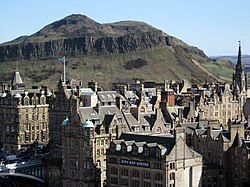 View over Edinburgh | |
| Location | |
| Location: | 55°56’55"N, 3°12’3"W |
| Data | |
| Population: | 477,660 |
| Post town: | Edinburgh |
| Postcode: | EH |
| Dialling code: | 0131 |
| Local Government | |
| Council: | Edinburgh |
Edinburgh, in the heart of Midlothian, is the capital city of Scotland, and the second largest after Glasgow. It is said to be Britain's most beautiful city. Edinburgh stands close to the Firth of Forth, its port, Leith, on the south side of the water looking out toward Fife.
Standing at the heart of the city is Castle Rock, crowned by Edinburgh Castle, from which runs the old town, down toward the royal palace of Holyrood House, a way full of history, commerce and academia, while across the Princes Street Gardens lies the grand Georgian New Town, all together making Edinburgh a city magnificent in its bearing.
The City
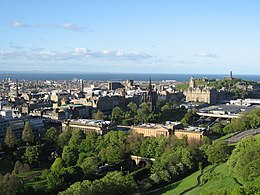
Edinburgh's setting is amongst natural spectacle; Castle Rock rises sheer out of the city, an old volcanic plug whose raw rock yet displays itself to the city it dominates. This was the founding place of the city, the fortified burg around which a town grew.
The city is built on and around the slopes of Castle Rock and several neighbouring hills which rise up throughout the city, a rugged setting across which are built a delightful collection of mediaeval and Georgian architecture, stone tenements, and modern works, It is perhaps Britain's most beautiful city, and of the most picturesque in Europe.
Within the city itself, a little outside the ancient centre, is Arthur's Seat, a rocky hill of 823 feet.
The city attracts 1 million overseas visitors a year, making it the second most visited tourist destination in the United Kingdom, after London.[1] In a 2009 YouGov poll, Edinburgh was voted the "most desirable city in which to live in the United Kingdom".[2] Edinburgh was also rated The Best Place to Live in Channel 4's 2007 4Homes survey.[3]
The city was one of the major centres of the Enlightenment, led by the University of Edinburgh, earning it the nickname Athens of the North. There are over 4,500 listed buildings within the city.[4] In May 2010, it had a total of 40 conservation areas covering 23% of the building stock and 23% of the population, the highest such ratios of any major city in the United Kingdom.[5] In the 2009 mid year population estimates, Edinburgh had a total resident population of 477,660.[6] The Old Town and New Town districts of Edinburgh were listed as a UNESCO "World Heritage Site" in 1995.
The Castle
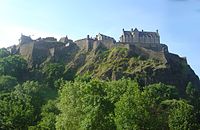
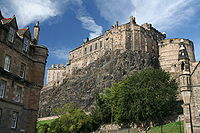
Edinburgh Castle stands high on a precipitous rock looking out over the city. This ancient fortress place was the city's foundation and remains its heart. In a city of grand sights, Edinburgh Castle is the foremost attraction. From its gate the Royal Mile runs downhill through the Old Town toward the Palace of Holyroodhouse.
The "Honours of Scotland", the Crown Jewels, are housed in the Castle. There too since 1996 has been the Stone of Scone, the ancient coronation stone of Scotland, which had been held since the days of Edward I in Westminster.
The One O'Clock Gun is fired every day from the Castle at precisely 13:00, excepting the Sabbath, Good Friday and Christmas Day. The gun was established in 1861 as a time signal for ships in the Firth of Forth, and complemented the time ball installed on Nelson's Monument in 1852, but which was useless during foggy weather.
The Castle has a permanent garrison. The Governor of Edinburgh Castle, though now a ceremonial post, is the General Officer Commanding the Army's 2nd Division. The New Barrack Block is home to the Home Headquarters of the Royal Regiment of Scotland and 52 Infantry Brigade.
Festivals
The Edinburgh Festival
The yearly Edinburgh Festival is one of the largest and most famous arts festivals in the English-speaking world. It consists of a collection of official and independent festivals held over about four weeks from early August. The number of visitors attracted to Edinburgh for the Festival is roughly equal to the settled population of the city. The most best known of these events are the Edinburgh Fringe, the Edinburgh International Festival, the Edinburgh Military Tattoo, and the Edinburgh International Book Festival.
Others
Other events in Edinburgh include the Hogmanay street party (31 December), Burns Night (25 January) and the Beltane Fire Festival (30 April).
Geography
Hills

Bounded by the Firth of Forth to the north and the Pentland Hills, which skirt the periphery of the city to the south, Edinburgh lies in the eastern portion of the Central Lowlands of Scotland.[7] The city sprawls over a landscape which is the product of early volcanic activity and later periods of intensive glaciation.[8] Igneous activity between 350 and 400 million years ago, coupled with faulting led to the dispersion of tough basalt volcanic plugs, which predominate over much of the area.[8] One such example is Castle Rock which forced the advancing icepack to divide, sheltering the softer rock and forming a mile-long tail of material to the east, creating a distinctive crag and tail formation.[8] Glacial erosion on the northern side of the crag gouged a large valley resulting in the now drained Nor Loch. This structure, along with a ravine to the south, formed an ideal natural fortress which Edinburgh Castle was built upon.[8]
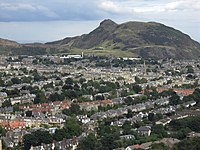
Similarly, Arthur's Seat is the remains of a volcano system dating from the Carboniferous period, which was eroded by a glacier moving from west to east during the ice age.[8] Erosive action such as plucking and abrasion exposed the rocky crags to the west before leaving a tail of deposited glacial material swept to the east.[9] This process formed the distinctive Salisbury Crags, which formed a series of teschenite cliffs located between Arthur's Seat and the city centre.[10] The residential areas of Marchmont and Bruntsfield are built along a series of drumlin ridges located south of the city centre which were glacial deposition|deposited as the glacier receded.[8]
Other viewpoints in the city such as Calton Hill and Corstorphine Hill are similar products of glacial erosion.[8] The Braid Hills and Blackford Hill are a series of small summits to the south west of the city commanding expansive views over the urban area of Edinburgh and northwards to the Forth.[8]
Water
Edinburgh is drained by the Water of Leith, which finds its source at the Colzium Springs in the Pentland Hills and runs for 18 miles through the south and west of the city, emptying into the Firth of Forth at Leith.[11] The nearest the river gets to the city centre is at Dean Village on the edge of the New Town, where a deep gorge is spanned by the Dean Bridge, designed by Thomas Telford and built in 1832 for the road to Queensferry.[11] The Water of Leith Walkway is a mixed use trail that follows the river for over 12 miles from Balerno to Leith.[12]
Green Belt
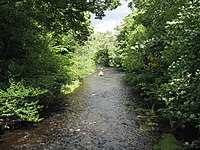
Designated in 1957, Edinburgh is ringed by a green belt stretching from Dalmeny in the west to Prestongrange in the east.[13]
With an average width of 2 miles, the principal objective of the green belt was to contain the outward expansion of Edinburgh and to prevent the agglomeration of urban areas.[13] Expansion within the green belt is strictly controlled but developments such as Edinburgh Airport and the Royal Highland Showground at Ingliston are located within the zone.[13] Similarly, urban villages such as Juniper Green and Balerno sit on green belt land.[13] One feature of the green belt in Edinburgh is the inclusion of parcels of land within the city which are designated as green belt even though they do not adjoin the main peripheral ring. Examples of these independent wedges of green belt include Holyrood Park and Corstorphine Hill.[13]
History
Early history
Traces of primitive Bronze Age settlemens have been found at Holyrood, Craiglockhart Hill and amongst the Pentland Hills.[14] By the time the Romans reached the Lothians at the beginning of the 1st millennium AD, they discovered an Iron Age Brythonic tribe whose name they recorded as Votadini, apparently a Latin version of Gododdin.
There is a difference of opinion as to the origin of the name Edinburgh. The second element is Old English (burh) and the first may be English or from an older origin in the Brythoic (Old Welsh) language.[15] One theory is that Edinburgh was the Din Eidyn (Fort of Eidyn) referred to in the poem Y Gododdin as a stronghold of the Gododdin tribe.[16][17][18] Others hold that the name comes from the English king Edwin King the Northumbrians, making it Edwinesburh ("Edwin's fort"), and that the name Din Eidyn in British writings is an anachronism or back-formation.[19][20][21][22][23][24] The name Din Eidyn first appears in the Y Gododdin, a poem which appears after the fall of the British city to the English. The oldest manuscript of the Y Gododdin, The Book of Aneirin is from about 1265.[25] Most scholars usually considered to be that of the 9th or 10th centuries, although some scholars consider that it could be from the 11th century.[26]
Edinburgh fell within the realm of the Gododdin until in 638 AD the Gododdin were overthrown and Edinburgh became part of the Kingdom of Bernicia, later part of the Kingdom of the Northumbrians. In the ninth century Northumbria was overrun by Norwegian warriors, who established their capital in York and settled the land heavily. However it appear that the Norse did not penetrate this far; place name evidence suggests that the River Tees was the effective northern boundary of the Norse kingdom and English rule survived beyond.
The Norse kingdom was finally, permanently banished by King Eadred in 954, but by this time the position of the northern English had been fatally weakened. At some time about 950, during the reign of Indulf son of Constantine, the city (which the Pictish Chronicle called oppidum Eden)[15] fell to the Scots. It is uncertain whether Edinburgh remained under Indulf's rule permanenly or what form the city took at this stage, but chronicles record that the city had to be abandoned, the Norse irruption having permanently weakened this remnant of the Northumbrian state.
Middle Ages
By the 12th century Edinburgh was well established, founded upon the famous castle rock, the volcanic crag and tail geological feature shaped by 2 million years of glacial activity. Flourishing alongside it to the east, another community developed around the Abbey of Holyrood, known as Canongate. In the 13th century these both became Royal Burghs and through the late mediaeval period Edinburgh grew quickly.
In 1492 King James IV of Scotland undertook to move the royal court from Stirling to Holyrood in Edinburgh, making Edinburgh the national capital. Edinburgh continued to flourish economically and culturally through the Renaissance period.
Modern period
Edinburgh was at the centre of the Scottish Reformation of the 16th century and of the disputes which erupted into the Wars of the Covenant a hundred years later.
In 1603 King James VI of Scotland succeeded to the English and Irish thrones, fulfilling his ambition to create a united kingdom under the Stuart Monarchy. Although he retained the Parliament of Scotland in Edinburgh, he progressed to London to rule from his throne there returning to Edinburgh only once, in 1617.
In 1639, disputes between the Presbyterian Covenanters and the Episcopal establishment of the Church of Scotland led to the Bishops' Wars, the initial conflict of the Wars of the Three Kingdoms. In 1649, King Charles I was beheaded in Whitehall but in Edinburgh is son was recognised as King Charles II. In 1650 during the Civil War, Edinburgh was taken by the Commonwealth forces of Oliver Cromwell before Charles II's eventual defeat at the Battle of Worcester.
In 17th century Edinburgh's bounds were still defined by the Flodden Wall, a defensive wall built in the 16th century as protection against English invasion following James IV's defeat at Flodden. The wall restricted the land available for development so the city's houses increased in height instead. Buildings of 11 stories were common, and there are records of buildings as high as 14 stories, remarkable by the standards of the day. Many of the stone-built structures can still be seen today in the Old Town.
In 1707 the Act of Union was passed by the Parliament of Scotland, at which news the people of Edinburgh rioted, and Edinburgh ceased to be a political capital. It remained however home of the Court of Session (which sits now in Parliament House) and of the High Court of Justiciary, and of the University of Edinburgh. Thus Edinburgh remained the centre for the legal profession and of intellectual life.
Georgian Edinburgh
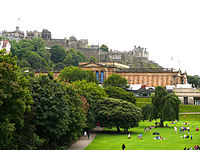
During the Jacobite rising of 1745, Edinburgh was briefly occupied by Jacobite forces, though the Castle garrison held out for the king, and when the rebels marched south Edinburgh was evacuated. The Jacobites were crushed at Culloden the next year and Edinburgh could begin to flourish. King George supported new developments to the north of the castle, which became the New Town. Here there are several streets named in honour of the King and the Royal family, including George Street, Frederick Street, Hanover Street and Princes Street, named in honour of George III's two sons.
Edinburgh is noted for its fine architecture, and the New Town for its Georgian architecture in particular.
The city was at the heart of the Scottish Enlightenment and renowned throughout Europe at this time, as a hotbed of talent and ideas and a beacon for progress. Celebrated thinkers from across Britain and from Europe would be seen in the city streets, among them famous Scots such as David Hume, Walter Scott, Robert Adam, David Wilkie, Robert Burns, James Hutton and Adam Smith. Edinburgh became a major cultural centre, earning it the nickname Athens of the North because of the Greco-Roman style of the New Town's architecture, as well as the rise of the Scottish intellectual elite who were increasingly leading both Scottish and European intellectual thought.
Victorian Edinburgh
In the 19th century, Edinburgh, like many cities, industrialised, but did not grow as fast as Scotland's second city, Glasgow, which replaced it as the largest city in the country, benefitting greatly at the height of the British Empire.
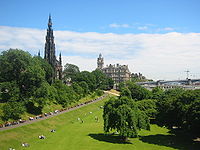
Nicknames
The city is affectionately nicknamed Auld Reekie[27] (Scots for Old Smoky), because when buildings were heated by coal and wood fires, chimneys would spew thick columns of smoke into the air. The colloquial pronunciation "Embra" or "Embro" has also been used[28] as in Robert Garioch's Embro to the Ploy.[29]
Some have called Edinburgh the Athens of the North. It is also known by several Latin names; Aneda or Edina. The adjectival form of the latter, Edinensis, can be seen inscribed on many educational buildings.[30][31]
Edinburgh has also been named romantically Dunedin, as a Gaelicization of the English name (its Scottish Gaelic name being Dùn Èideann, derived from the English). The city of Dunedin in New Zealand, was originally called "New Edinburgh" and is still nicknamed the "Edinburgh of the South".
The Scots poets Robert Burns and Robert Fergusson sometimes used the city's Latin name, Edina. Ben Jonson described it as Britain's other eye,[32] and Sir Walter Scott referred to the city as yon Empress of the North.[33] Robert Louis Stevenson, also a son of the city, wrote, "Edinburgh is what Paris ought to be".

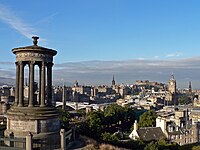
Parts of the city
Edinburgh is divided into areas that generally encompass a park (sometimes known as "links"), a main local street (which is to say a street of local retail shops), a high street (the historic main street, not always the same as the main local street, such as in Corstorphine) and residential buildings. In Edinburgh many residences are tenements, although the more southern and western parts of the city have traditionally been more affluent and have a greater number of detached and semi-detached villas.
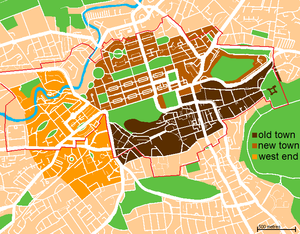
The historic centre of Edinburgh is divided into two by the broad green swath of Princes Street Gardens. To the south the view is dominated by Edinburgh Castle, perched atop the extinct volcanic crag, and the long sweep of the Old Town trailing after it along the ridge. To the north lies Princes Street and the New Town. The gardens were begun in 1816 on bogland which had once been the Nor Loch.
To the immediate west of the castle lies the financial district, housing insurance and banking buildings. Probably the most noticeable building here is the circular sandstone building that is the Edinburgh International Conference Centre.
Old Town
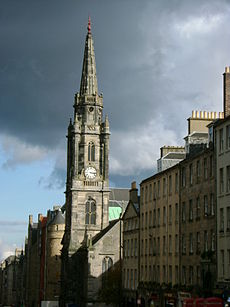
The Old Town has preserved its mediæval plan and many Reformation-era buildings. One end is closed by the castle and the main artery, the Royal Mile, leads away from it; minor streets (called closes or wynds) lead downhill on either side of the main spine in a herringbone pattern. Large squares mark the location of markets or surround public buildings such as the High Kirk of St Giles' (Edinburgh Cathedral) and the Law Courts.
Other notable places nearby include the Royal Museum of Scotland, Surgeons' Hall and McEwan Hall. The street layout is typical of the old quarters of many northern European cities, and where the castle perches on top of a rocky crag the Royal Mile runs down the crest of a ridge from it.
Due to space restrictions imposed by the narrowness of the "tail", the Old Town became home to some of the earliest "high rise" residential buildings. Multi-storey dwellings known as lands were the norm from the 16th century onwards with ten and eleven stories being typical and one even reaching fourteen stories. Additionally, numerous vaults below street level were inhabited to accommodate the influx of Irish immigrants during the Industrial Revolution. These continue to fuel legends of an underground city to this day. Today there are tours of Edinburgh which take you into the underground city, Edinburgh Vaults.[34]

New Town
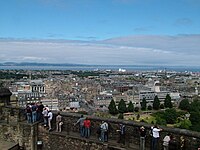
The New Town was an 18th-century solution to the problem of an increasingly crowded Old Town. The city had remained incredibly compact, confined to the ridge running down from the castle.
In 1766 a competition to design the New Town was won by James Craig, a 22-year-old architect. The plan that was built created a rigid, ordered grid, which fitted well with enlightenment ideas of rationality. The principal street was to be George Street, which follows the natural ridge to the north of the Old Town. Either side of it are the other main streets of Princes Street and Queen Street. Princes Street has since become the main shopping street in Edinburgh, and few Georgian buildings survive on it. Linking these streets were a series of perpendicular streets. At the east and west ends are St Andrew Square and Charlotte Square respectively. The latter was designed by Robert Adam and is often considered one of the finest Georgian squares in the world. Bute House, now the official residence of the First Minister of Scotland, is on the north side of Charlotte Square.
Sitting in the glen between the Old and New Towns was the Nor Loch, which had been both the city's water supply and place for dumping sewage, an unfortunate combination. By the 1820s the loch was drained. Craig's original plans included the ornamental Princes Street Gardens and a canal[35] in place of the Nor Loch. However excess soil from the construction of the buildings was dumped into the loch, creating what is now The Mound and the canal idea was abandoned. In the mid-19th century the National Gallery of Scotland and Royal Scottish Academy Building were built on The Mound, and tunnels to Waverley Station driven through it.
The New Town was so successful that it was extended greatly. The grid pattern was not maintained, but rather a more picturesque layout was created. Today the New Town is considered by many to be one of the finest examples of Georgian architecture and planning in the world.

South side
Edinburgh "South side" is a popular residential part of the city is its south side, comprising a number of areas including St Leonards, Marchmont, Newington, Sciennes, The Grange. It is broadly the area covered by the Burgh Muir, and grew in popularity as a residential area following the opening of the South Bridge. These areas are particularly popular with families (many well-regarded state and private schools are located here), with students (the central University of Edinburgh campus is based around George Square just north of Marchmont and the Meadows, and Napier University has major campuses around Merchiston & Morningside), and with festival-goers.
These South Side areas have appeared in the city's literary fiction, giving home to such characters as Ian Rankin's Inspector Rebus (Marchmont and St Leonards) and Muriel Spark's Miss Jean Brodie (Morningside). The authors J K Rowling, Ian Rankin and Alexander McCall Smith live in the South Side.
Leith
- Main article: Leith
Leith is the port of Edinburgh on the coast of the Firth of Forth. It still retains a separate identity from Edinburgh, and it was a matter of great resentment when, in 1920, the burgh of Leith was merged[36] into the City of Edinburgh for local government purposes. With the redevelopment of Leith, Edinburgh has gained the business of a number of cruise liner companies which now provide cruises to Norway, Sweden, Denmark, Germany and the Netherlands. The Royal Yacht Britannia now lies at berth in Leith, behind the Ocean Terminal.
Culture
Festivals
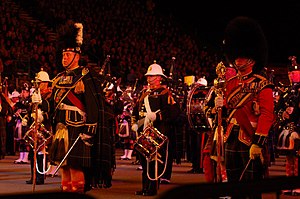
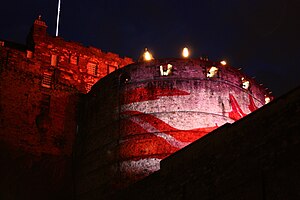
Culturally, Edinburgh is best known for the Edinburgh Festival, which is a series of separate events, which run from the end of July until early September each year. The longest established festival is the Edinburgh International Festival, which first ran in 1947. The International Festival centres on a programme of high-profile theatre productions and classical music performances, featuring international directors, conductors, theatre companies and orchestras.
The International Festival has since been taken over in both size and popularity by the Edinburgh Fringe. What began as a programme of marginal acts has become the largest arts festival in the world, with 1867 different shows being staged in 2006, in 261 venues. Comedy is now one of the mainstays of the Fringe, with numerous notable comedians getting their 'break' here, often through receipt of the Perrier Award.
In 2008 the largest comedy venues on the Edinburgh Fringe launched as a festival within a festival, labelled the Edinburgh Comedy Festival. Already at its inception it was the largest comedy festival in the world.[37] Alongside these major festivals, there is also the Edinburgh Art Festival, Edinburgh International Film Festival (moved to June from 2008), the Edinburgh Jazz and Blues Festival, and the Edinburgh International Book Festival. The Edge Festival (formerly known as T on the Fringe), a popular music offshoot of the Fringe, began in 2000, replacing the smaller Flux and Planet Pop series of shows.
Running concurrently with the summer festivals, the Edinburgh Military Tattoo occupies the Castle Esplanade every night, with massed bagpipes|pipers and fireworks.
The Edinburgh International Science Festival is held annually in April and is one of the most popular science festivals in the world.
Celebrations
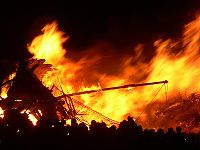
Equally famous is the annual Hogmanay celebration. Originally a street party held on Princes Street and the Royal Mile, the Hogmanay event has been officially organised since 1993. In 1996, over 300,000 people attended, leading to ticketing of the main street party in later years, with a limit of 100,000 tickets. Hogmanay now covers four days of processions, concerts and fireworks, with the street party commencing on Hogmanay. During the street party Princes Street is accessible by ticket only, allowing access into Princes Street where there are live bands playing, food and drink stalls, and a clear view of the castle and fireworks. Alternative tickets are available for entrance into the Princes Street Gardens concert and Ceilidh, where well known artists perform and ticket holders are invited to participate in traditional Scottish Ceilidh dancing. The event attracts thousands of people from all over the world.
Museums and libraries
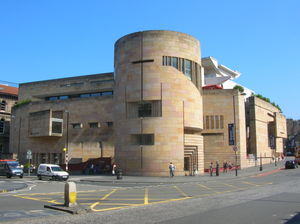
Edinburgh is home to a large number of museums and libraries, many of which are national institutions. These include the Museum of Scotland, the Royal Museum, the National Library of Scotland, National War Museum of Scotland, the Museum of Edinburgh, Museum of Childhood and the Royal Society of Edinburgh.
Literature and philosophy
Edinburgh has a long literary tradition, going back to the Scottish Enlightenment. Edinburgh's Enlightenment produced philosopher David Hume and the pioneer of political economy, Adam Smith. Writers such as James Boswell, Robert Louis Stevenson, Sir Arthur Conan Doyle, and Sir Walter Scott all lived and worked in Edinburgh. J K Rowling, author of the Harry Potter novels, is a resident of Edinburgh. Edinburgh has also become associated with the crime novels of Ian Rankin, and the work of Irvine Welsh, whose novels are mostly set in the city and are often written in colloquial Scots. Edinburgh is also home to Alexander McCall Smith.
Edinburgh has been declared the first UNESCO City of Literature.
Churches
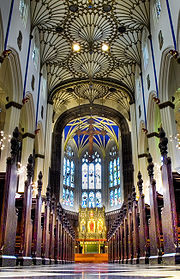
Church of Scotland
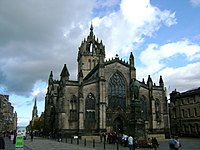
The Church of Scotland claims the largest membership of any religious denomination in Edinburgh. Its most important and historical church is the High Kirk of St Giles, more commonly known as St Giles' Cathedral. It served as cathedral for the Bishops of Edinburgh untl the Kirk adopted Presbyterian church government.
The most notable Church of Scotland churches in the city are:
- St Giles' Cathedral
- Greyfriars Kirk
- Barclay Church
- Canongate Kirk
- St Andrew's and St George's Church
- Duddingston Kirk (In the southeast of the city, a 12th-century church)
The Church of Scotland Offices are located in Edinburgh, as is the General Assembly Hall of the Church of Scotland and New College on The Mound.
Others
- Free Church of Scotland (Reformed and Presbyterian):
- congregations on the Royal Mile and Crosscauseway. Its offices and training college are located on the Mound.
- Scottish Episcopal Church (part of the Anglican Communion):
- St Mary's Cathedral (late 19th century Gothic) in the West End's Palmerston Place
- Old Saint Paul's, off the Royal Mile, established in 1689 as a "pro-cathedral" when St Giles and the wider Church of Scotland converted from Episcopal to Presbyterian governance
- a number of churches across the city
- Baptist:
- Charlotte Chapel (Baptist)
- Morningside Baptist Church
- Other non-conformist and independent Protestant churches include:
- Destiny Church
- The Rock Elim Church
- Carrubbers Christian Centre
- Bellevue Chapel
- Roman Catholic:
- St. Mary's Cathedral
- Sacred Heart of Jesus
- St Patrick's
- St. Columba's
Other religions
- Jewish:
- Orthodox synagogue in Salisbury Road
- Liberal synagogue
- Muslim: Edinburgh Central Mosque, on Potterrow on the city's southside, largely financed by a gift from King Fahd of Saudi Arabia.[38]
Economy
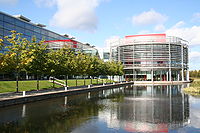
Edinburgh is the most competitive large city in the United Kingdom according to the Centre for International Competitiveness.[39] Edinburgh also has the highest [Gross value added per employee figure of any city in the United Kingdom outside London, measuring £50,256 in 2007.[40] A combination of these factors saw Edinburgh named the Best Small City of the future by fDi Magazine for 2010/11.[41] Education and health, finance and business services, retailing and tourism are the largest employers.[42]
The economy of Edinburgh is largely based on the services sector — centered around banking, financial services, higher education, and tourism. As of March 2010 unemployment in Edinburgh was comparatively low at 3.6%, and remains consistently below the Scottish average of 4.5%.[43] Banking has been a part of the economic life of Edinburgh for over 300 years. The Bank of Scotland (now part of the Lloyds Banking Group) was established by an act of the Parliament of Scotland in 1695. Today, together with the financial services industry, with particular strengths in insurance and investment underpinned by the presence of Edinburgh-based firms such as Scottish Widows and Standard Life, Edinburgh is the United Kingdom's second financial centre, after London, and Europe's fourth by equity assets.[44] In world terms, Edinburgh ranks ahead of Dubai, Amsterdam and Washington in the Global Financial Centres Index.[44]
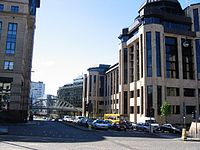
Tourism is an important economic mainstay in the city. As a World Heritage Site, tourists come to visit such historical sites as Edinburgh Castle, the Palace of Holyroodhouse and the Georgian New Town. This is augmented in August of each year with the presence of the Edinburgh Festivals, which bring over 4.4 million visitors to town,[43] and generate in excess of £100 million for the Edinburgh economy.[45]
Edinburgh is the centre of the Scottish legal system, home to the Court of Session and the High Court, and since devolution is has been home to Scotland's devolved government, so the public sector plays an important role in the economy of Edinburgh too.
Universities
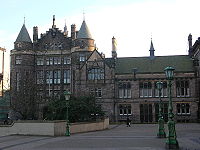
There are four universities in Edinburgh with over 100,000 students studying in the city.[46]
The University of Edinburgh
Established by a Royal Charter of King James VI in 1583, the University of Edinburgh is one of Scotland's ancient universities, beaten in age in the English-speaking world only by the Universities of Oxford, Cambridge, St Andrews, Glasgow and Aberdeen.[47] The University had its original centred around Old College but has expanded to premises on The Mound, the Royal Mile and George Square.[47]
Today, the King's Buildings in the south of the city contain most of the schools within the College of Science and Engineering. In 2002, the University of Edinburgh Medical School moved to purpose-built accommodation adjacent to the new Edinburgh Royal Infirmary at Little France.
The University was voted 20th in the world in the 2009 THES World University Rankings.[48]
Heriot-Watt University
In the 1960s, Heriot-Watt University and Napier Technical College were established.[47] Heriot-Watt traces its origins to 1821, when a school for technical education of the working classes was opened.[49] Based in Riccarton to the west of the city, Heriot-Watt specialises in the disciplines of engineering, business and mathematics.[50]
Napier
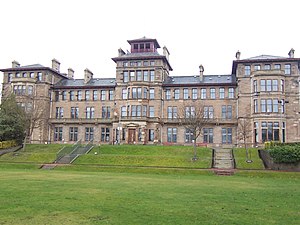
Napier College was renamed Napier Polytechnic in 1986 and gained university status in 1992.[51] Edinburgh Napier University has campuses in the south and west of the city, including the former Craiglockhart Hydropathic and Merchiston Tower.[51] It is home to the Screen Academy Scotland.
Queen Margaret University
Awarded university status in January 2007, Queen Margaret University was founded in 1875, as The Edinburgh School of Cookery and Domestic Economy, by Christian Guthrie Wright and Louisa Stevenson.[52]
Medical schools and art schools
Other notable institutions in Edinburgh include the Royal College of Surgeons of Edinburgh and the Royal College of Physicians of Edinburgh, which were established by Royal Charter, in 1506 and 1681 respectively.
The Trustees Drawing Academy of Edinburgh was founded in 1760 - an institution that became the Edinburgh College of Art in 1907.[53]
Sources
- ↑ "National Statistics Online - International Visits". ONS. http://www.statistics.gov.uk/cci/nugget.asp?id=178. Retrieved 2009-07-19.
- ↑ Edinburgh voted most desirable city to live in www.edinburgh-inspiringcapital.com, 14 August 2009
- ↑ http://www.channel4.com/4homes/on-tv/best-and-worst/edinburgh-the-best-place-to-live-in-the-uk-08-06-03_p_1.html
- ↑ "Conservation in Edinburgh". The City of Edinburgh Council. Archived from the original on 2007-05-22. http://web.archive.org/web/20070522050108/http://www.edinburgh.gov.uk/internet/Environment/Planning_buildings_i_i_/Built_heritage/CEC_conservation_in_edinburgh_. Retrieved 2007-05-20.
- ↑ City of Edinburgh statistics, May 2010.
- ↑ "General Register Office for Scotland - mid 2009 population estimates by sex, single year of age and administrative area". http://www.gro-scotland.gov.uk/statistics/publications-and-data/population-estimates/mid-year/mid-2009-pop-est/list-of-tables.html.
- ↑ "Overview of Edinburgh". Gazetteer for Scotland, University of Edinburgh. http://www.geo.ed.ac.uk/scotgaz/towns/townfirst337.html. Retrieved 2009-03-15.
- ↑ 8.0 8.1 8.2 8.3 8.4 8.5 8.6 8.7 J Stuart Murray in Edwards & Jenkins (2005); p64-65
- ↑ Stuart Piggott (1982). Scotland before History. Edinburgh University Press. ISBN 0-85224-470-3.
- ↑ "Holyrood Park Geology". Department of Geography, University of Edinburgh. http://www.geo.ed.ac.uk/arthurseat/geology/geology.html. Retrieved 2007-07-20.
- ↑ 11.0 11.1 "Overview of the Water of Leith". Gazetteer for Scotland, Institute of Geography, University of Edinburgh. http://www.geo.ed.ac.uk/scotgaz/features/featurefirst2805.html. Retrieved 2009-04-19.
- ↑ "The Water of Leith Walkway". Water of Leith Conservation Trust. http://www.waterofleith.org.uk/walkway/. Retrieved 2009-04-19.
- ↑ 13.0 13.1 13.2 13.3 13.4 G. Bramley, C. Hague, K. Kirk, A. Prior, J. Raemaekers and H. Smith (2004-08-11). "Review of Green Belt policy in Scotland - Edinburgh and Midlothian". Scottish Executive. http://www.scotland.gov.uk/Publications/2004/08/19785/41543. Retrieved 2009-04-10.
- ↑ Coghill, Hamish Lost Edinburgh pp. 1/2.
- ↑ 15.0 15.1 Watson, The Celtic Place Names of Scotland (1926), p.340
- ↑ Harris, The Place Names of Edinburgh(1996)
- ↑ Lownie, Auld Reekie, An Edinburgh Anthology (2004), p.10
- ↑ Gardens of the 'Gododdin' Craig Cessford Garden History, Vol. 22, No. 1 (Summer, 1994), pp. 114-115 doi:10.2307/1587005
- ↑ Campbell, Edinburgh: A Cultural and Literary History, 5.
- ↑ Blackie, Geographical Etymology: A Dictionary of Place-names Giving Their Derivations, 68.
- ↑ Davies, Europe: A History, 87.
- ↑ Swanton, The Anglo-Saxon Chronicle, 126.
- ↑ Jordan-Bychkov, The European Cultural Area, 243.
- ↑ Coghill, Hamish Lost Edinburgh p.3.
- ↑ http://www.maryjones.us/ctexts/aindex.html
- ↑ Evans 1982, p. 17.
- ↑ "Scottish Vernacular Dictionary". http://www.firstfoot.com/scottish_dictionary/glossword/index.php?a=term&t=52ad5c605eaa5661ad.
- ↑ "Embro, Embro - the hidden history of Edinburgh in its music". Purr.demon.co.uk. http://www.purr.demon.co.uk/embro/. Retrieved 2009-07-08.
- ↑ "Makars Literary Tour | Robert Garioch". Edinburghliterarypubtour.co.uk. http://www.edinburghliterarypubtour.co.uk/makars/garioch/embro.html. Retrieved 2009-07-08.
- ↑ "Orbis Latinus: Letter A". Columbia.edu. http://www.columbia.edu/acis/ets/Graesse/orblata.html. Retrieved 2009-07-08.
- ↑ "Pharmaceutical Latin Abbreviations". Herbdatanz.com. http://www.herbdatanz.com/pharmaceutical_latin_abbreviations.htm. Retrieved 2009-07-08.
- ↑ The Cambridge Companion to Ben Jonson. Retrieved 17 April 2007.
- ↑ Marmion A Tale of Flodden Field by Walter Scott. Retrieved 17 April 2007.
- ↑ Campbell, Donald (2003). Edinburgh – A Cultural and Literacy History. Oxford: Signal Books. ISBN 1-902669-73-8.
- ↑ History of princes Street Retrieved 7 June 2010
- ↑ "The Story of Leith XXXIII. How Leith was Governed". http://www.electricscotland.com/history/leith/33.htm.
- ↑ "Edinburgh Comedy Festival 2008 Introduction". Official site of the Edinburgh Comedy Festival. Archived from the original on 2008-06-26. http://web.archive.org/web/20080626173159/http://www.edcomfest.com/index.aspx. Retrieved 2008-02-04.
- ↑ "Financing the project". Edinburgh Islamic Centre. Archived from the original on 2007-09-28. http://web.archive.org/web/20070928192650/http://www.icetrust.org/col/htm/about/finance.htm. Retrieved 2007-03-23.
- ↑ "The United Kingdom Competitive Index 2010". Centre for International Competitiveness. http://www.cforic.org/pages/ukci2010.php. Retrieved 2010-05-10.
- ↑ "Edinburgh by Numbers 2010/2011". Edinburgh Inspiring Capital. http://www.edinburgh-inspiringcapital.com/invest/economic_data/publications/edinburgh_by_numbers.aspx. Retrieved 2010-05-10.
- ↑ "Edinburgh Awards and Accolades". City of Edinburgh Council. http://www.edinburgh-inspiringcapital.com/invest/awards_and_accolades.aspx. Retrieved 2010-05-10.
- ↑ "Edinburgh by Numbers 2010/2011". Edinburgh Inspring Capital. http://www.edinburgh-inspiringcapital.com/invest/economic_data/publications/edinburgh_by_numbers.aspx. Retrieved 2010-05-10.
- ↑ 43.0 43.1 "Edinburgh Economy Watch April 2010". City of Edinburgh Council. http://www.edinburgh-inspiringcapital.com/invest/economic_data/publications/edinburgh_economy_watch.aspx. Retrieved 2010-05-10.
- ↑ 44.0 44.1 "Edinburgh Inspiring Capital - Financial Services". Edinburgh Brand. http://www.edinburgh-inspiringcapital.com/invest/key_sectors/financial_services.aspx. Retrieved 2010-05-11.
- ↑ "2004 Festival Economic Impact Study results". Edinburgh Festival Fringe. 2005-10-14. Archived from the original on 2007-09-27. http://web.archive.org/web/20070927195132/http://www.edfringe.com/story.html?id=923. Retrieved 2007-03-23.
- ↑ "Edinburgh Life". Napier University. http://www.napier.ac.uk/napierlife/edinburghlife/Pages/default.aspx. Retrieved 2008-05-29.
- ↑ 47.0 47.1 47.2 Lynch, Michael (2001). The Oxford Companion to Scottish History. Oxford: Oxford University Press. pp. Pg. 610–615. ISBN 0192116967.
- ↑ "Education news, resources and university jobs for the academic world". Times Higher Education. http://www.timeshighereducation.co.uk/hybrid.asp?typeCode=430&pubCode=1&navcode=105. Retrieved 2010-01-25.
- ↑ "The History of Heriot-Watt University". Heriot-Watt University. Archived from the original on 2008-02-15. http://web.archive.org/web/20080215054251/http://www.hw.ac.uk/archive/histuni.htm. Retrieved 2008-05-30.
- ↑ "About Heriot-Watt University". Heriot-Watt University Careers Service. http://www.hw.ac.uk/careers/employers.php. Retrieved 2008-05-26.
- ↑ 51.0 51.1 "Napier University History". Napier University. http://www.news.napier.ac.uk/background/bkInfo6.htm. Retrieved 2008-05-30.
- ↑ "History: From Edinburgh School of Cookery to Queen Margaret University". Queen Margaret University. Archived from the original on 2008-02-08. http://web.archive.org/web/20080208140016/http://www.qmu.ac.uk/the_university_college/history.htm. Retrieved 2007-04-11.
- ↑ "Trustees Academy School of Art, Edinburgh". Gateway to the Archives of Scottish Higher Education (GASHE). Archived from the original on 2007-12-11. http://web.archive.org/web/20071211183456/http://www.gashe.ac.uk/isaar/C1267.html. Retrieved 2007-04-17.
- Campbell, Donald (2003). Edinburgh: A Cultural and Literary History. Signal Books. ISBN 1902669738.
Outside links
| Cities in the United Kingdom |
|---|
|
Aberdeen • Armagh • Bangor (Caernarfonshire) • Bangor (County Down) • Bath • Belfast • Birmingham • Bradford • Brighton and Hove • Bristol • Cambridge • Canterbury • Cardiff • Carlisle • Chelmsford • Chester • Chichester • Colchester • Coventry • Derby • Doncaster • Dundee • Dunfermline • Durham • Ely • Edinburgh • Exeter • Glasgow • Gloucester • Hereford • Inverness • Kingston upon Hull • Lancaster • Leeds • Leicester • Lichfield • Lincoln • Lisburn • Liverpool • City of London • Londonderry • Manchester • Milton Keynes • Newcastle upon Tyne • Newport • Newry • Norwich • Nottingham • Oxford • Perth • Peterborough • Plymouth • Portsmouth • Preston • Ripon • Rochester • Salford • Salisbury • Sheffield • Southampton • St Albans • St Asaph • St David's • Southend-on-Sea • Stirling • Stoke-on-Trent • Sunderland • Swansea • Truro • Wakefield • Wells • Westminster • Winchester • Wolverhampton • Worcester • Wrexham • York |